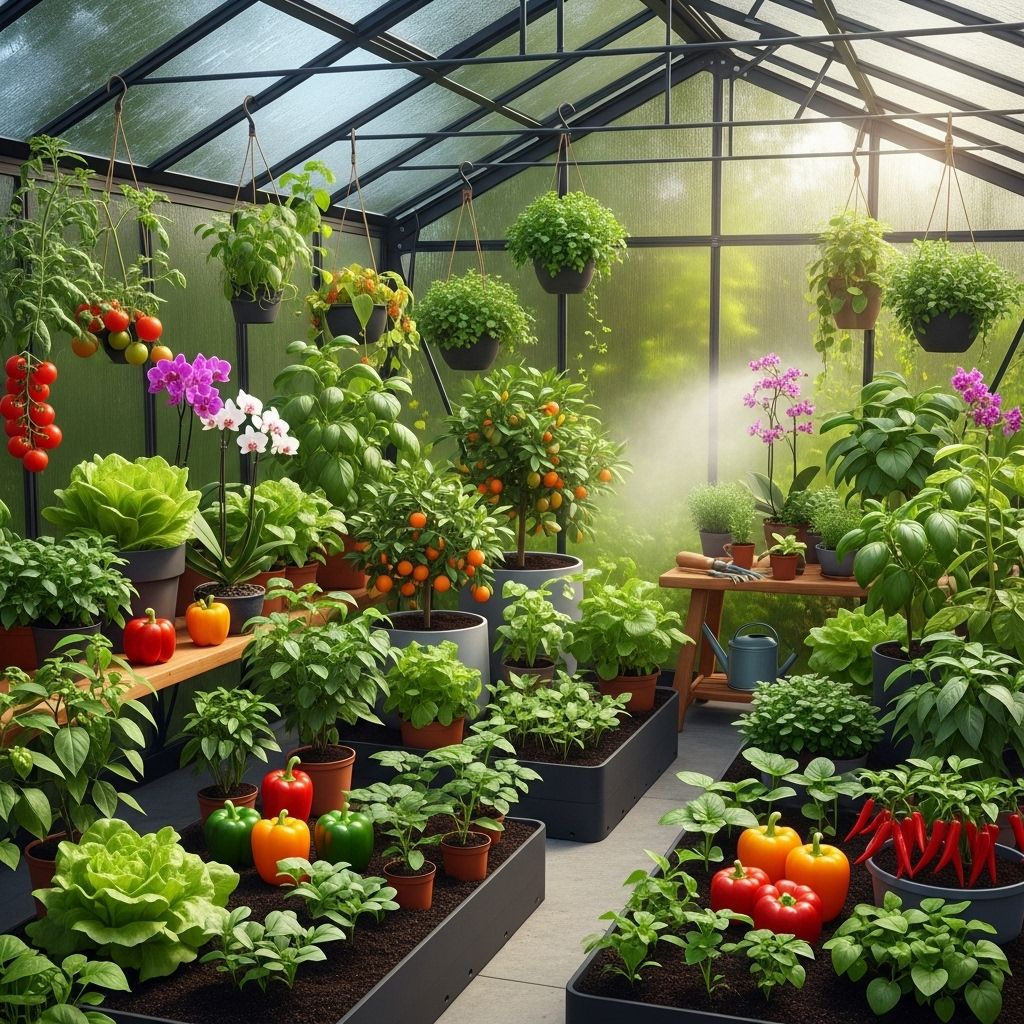Best Greenhouse Plants To Grow: 50 Picks For Year-Round Harvest
Discover the perfect plants to maximize your greenhouse growing throughout all seasons

Image: HearthJunction Design Team
The Ultimate Guide to Greenhouse Plants
Greenhouses create magical growing environments where gardeners can cultivate plants that might otherwise struggle in their local climate. Whether you’re a beginner greenhouse gardener or a seasoned expert looking to diversify your plant collection, this comprehensive guide covers the 50 best greenhouse plants to grow throughout the year. We’ve organized them into helpful categories to make planning your greenhouse garden easier and more efficient.
Tropical Houseplants for Greenhouse Growing
Tropical houseplants thrive in the warm, humid conditions that greenhouses naturally provide. These plants often struggle indoors due to low humidity levels, but a greenhouse environment allows them to flourish and reach their full potential.
Ficus Varieties
Ficus plants are perfect greenhouse specimens with their striking appearance and tropical feel. The greenhouse’s naturally humid environment keeps these plants particularly happy and thriving.
- Ficus audrey – A stunning variety with velvety leaves and an elegant growth habit
- Ficus benjamina – Also known as weeping fig, features graceful arching branches
- Ficus elastica – The popular rubber tree plant with glossy, leathery leaves
Taro Root
Instead of keeping taro plants near a humidifier indoors, grow them in your greenhouse where they can reach their full potential. Provide acidic soil enriched with well-rotted manure or high-quality compost to create ideal growing conditions. With proper care, you can harvest nutritious taro roots throughout the year while enjoying their beautiful, tropical foliage.
Ferns
Many fern varieties thrive in high-humidity areas, particularly in the shadier sections of the greenhouse. These plants add texture and lush greenery to your collection. Some excellent greenhouse fern varieties include:
- Rabbit’s foot fern – Features fuzzy rhizomes that resemble rabbit feet
- Staghorn fern – Distinctive fronds that resemble deer or elk antlers
- Bird’s nest fern – Forms a rosette of wavy fronds resembling a bird’s nest
These ferns appreciate temperate woodland environments that can be easily simulated in shadier areas of your greenhouse. Provide consistent moisture and indirect light for best results.
Vegetables for Greenhouse Cultivation
Growing vegetables in a greenhouse extends your growing season and allows you to harvest fresh produce year-round. Many vegetables thrive in the controlled environment of a greenhouse, often producing higher yields than outdoor gardens.
Tomatoes
Tomatoes are among the most popular greenhouse vegetables due to their extended growing season and improved yields when grown under cover. In a greenhouse environment, you can start tomatoes earlier and continue harvesting later than outdoor plants. Greenhouse tomatoes often produce cleaner fruits with fewer pest problems and diseases.
Peppers
Both sweet bell peppers and hot peppers thrive in the warm, protected environment of a greenhouse. The consistent heat helps peppers mature faster and can significantly extend your growing season. For best results, provide good air circulation and consistent watering to prevent blossom end rot.
Cucumbers
Greenhouse-grown cucumbers often produce straighter, cleaner fruits compared to garden-grown varieties. Trellising cucumber vines in the greenhouse maximizes space and improves air circulation around the plants. Consider growing parthenocarpic varieties that don’t require pollination for fruit development.
Lettuce and Leafy Greens
Lettuce, spinach, kale, and other leafy greens grow exceptionally well in greenhouses, especially during cooler seasons. With proper planning, you can maintain continuous harvests year-round. During warmer months, provide shade cloth to prevent bolting and bitter flavors in your greens.
Herbs for Year-Round Harvests
Herbs are perfect greenhouse companions, providing fresh flavors for your kitchen throughout the year. Many herbs that might struggle outdoors in winter thrive in the protected environment of a greenhouse.
Rosemary
Not only is growing rosemary possible in a greenhouse, but you can also propagate it there with excellent success rates. Use a heated propagator or even a non-heated propagator system for starting new plants. Established rosemary plants grow well in both warmer and cooler greenhouse conditions, providing year-round access to this versatile culinary herb.
Thyme
All varieties of thyme—including creeping thyme, lemon thyme, and wooly thyme—perform wonderfully in greenhouse environments. As long as you provide some heat and regular attention, these aromatic herbs will thrive. Thyme appreciates good air circulation and moderate watering, making it an ideal greenhouse herb.
Mint
Mint is one of the easiest herbs to grow in a greenhouse setting. The controlled environment prevents mint from spreading aggressively as it might in an outdoor garden. Provide plenty of light, warmth, and consistent moisture to keep mint plants productive and flavorful year-round.
Basil
Basil thrives in the warm, humid conditions of a greenhouse. While outdoor basil often struggles in cooler temperatures, greenhouse-grown plants can produce for much longer periods. Harvest regularly to encourage bushier growth and prevent flowering, which can make the leaves bitter.
Flowering Plants for Greenhouse Beauty
Flowering plants add color and interest to your greenhouse while benefiting from the protected growing environment. Many flowering plants bloom for extended periods when grown under glass.
Orchids
The controlled humidity and temperature of a greenhouse create ideal conditions for various orchid species. From dramatic Phalaenopsis to delicate Dendrobiums, orchids thrive in greenhouse environments. Provide appropriate growing media, filtered light, and good air circulation for healthy, blooming plants.
Hibiscus
Tropical hibiscus plants produce stunning blooms in a greenhouse environment. The consistent warmth and humidity encourage continuous flowering throughout much of the year. Provide regular fertilization and pruning to maintain plant health and encourage abundant blossoms.
Geraniums
Greenhouse-grown geraniums can bloom almost year-round with proper care. These versatile flowering plants are available in countless colors and varieties, from traditional zonal geraniums to ivy and scented types. Regular deadheading and feeding will keep plants looking their best.
Exotic Fruits for Greenhouse Experimentation
A greenhouse opens up possibilities for growing exotic fruits that wouldn’t normally thrive in your climate. While these plants may take longer to produce, the rewards are worth the patience.
Citrus Trees
Lemons, limes, oranges, and other citrus varieties can be successfully grown in greenhouse environments. The protected setting allows these tropical and subtropical trees to thrive even in colder climates. Provide plenty of sunlight, consistent moisture, and regular feeding for healthy growth and fruit production.
Coffee Plants
Coffee plants make fascinating greenhouse specimens, with glossy green foliage and eventually white, jasmine-scented flowers followed by berries. While producing enough coffee beans for regular consumption requires multiple mature plants, even a single specimen adds tropical interest to your greenhouse collection.
Pineapple
Pineapples can be grown from the tops of store-bought fruits, making them a fun and economical greenhouse project. While they require patience—typically 2-3 years to produce fruit—the novelty of harvesting your own pineapple makes the wait worthwhile.
Tips for Greenhouse Plant Success
Regardless of which plants you choose to grow, these general guidelines will help ensure success in your greenhouse garden:
- Monitor temperature: Install thermometers to track both daytime and nighttime temperatures
- Provide ventilation: Ensure proper air circulation to prevent disease issues
- Manage humidity: Different plants have different humidity requirements
- Water appropriately: Check soil moisture regularly and adjust watering schedules seasonally
- Control pests early: Inspect plants regularly and address pest issues promptly
Seasonal Greenhouse Growing Calendar
To maximize your greenhouse throughout the year, follow this basic seasonal guide:
| Season | Focus Activities | Ideal Plants to Start |
|---|---|---|
| Winter | Seed starting, growing greens, caring for tropicals | Tomatoes, peppers, eggplant seedlings |
| Spring | Transplanting seedlings, direct sowing warm-season crops | Cucumbers, melons, summer flowers |
| Summer | Managing heat, providing shade, harvesting | Fall greens, second plantings of quick crops |
| Fall | Extending harvests, bringing in tender perennials | Winter greens, herbs, cool-season crops |
Frequently Asked Questions
Q: Do I need to pollinate plants in my greenhouse?
A: For many fruiting plants like tomatoes, peppers, and cucumbers, you’ll need to either hand-pollinate or open the greenhouse to allow pollinators access during flowering. Some cucumber varieties are parthenocarpic, meaning they don’t require pollination to produce fruit.
Q: How do I control temperature in my greenhouse?
A: Use ventilation, shade cloth, and possibly heating systems depending on your climate. Automatic vent openers are valuable investments for maintaining appropriate temperatures.
Q: How often should I water greenhouse plants?
A: Watering needs vary greatly by plant type, container size, temperature, and humidity. Check soil moisture regularly rather than following a strict schedule. Many greenhouse growers find that drip irrigation systems provide consistent moisture with minimal effort.
Q: What’s the best way to control pests in a greenhouse?
A: Practice good sanitation, inspect plants regularly, introduce beneficial insects, and use organic pest control methods when necessary. Catching problems early is crucial in the enclosed greenhouse environment.
Q: Can I grow all these plants in a small greenhouse?
A: While you may not be able to grow all 50 plants simultaneously in a small space, you can rotate crops seasonally and choose varieties suited to your particular greenhouse size and conditions.
With proper planning and care, your greenhouse can become a year-round growing paradise, providing beauty, fresh food, and gardening enjoyment regardless of the weather outside. Start with plants that particularly interest you, then gradually expand your collection as you gain experience with greenhouse gardening.
References
Read full bio of Anjali Sayee












